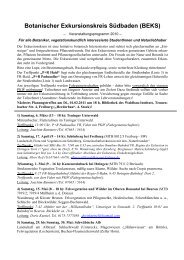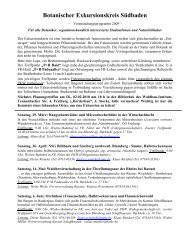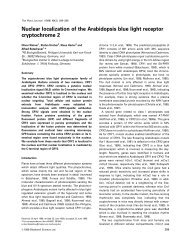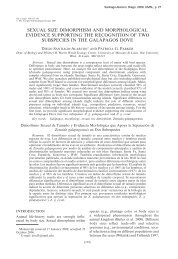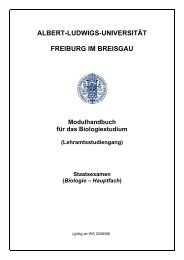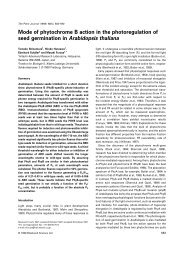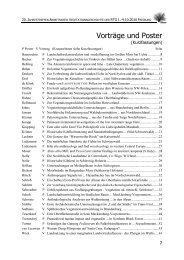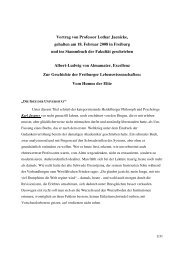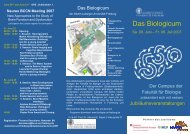Light-controlled growth of the maize seedling mesocotyl: Mechanical ...
Light-controlled growth of the maize seedling mesocotyl: Mechanical ...
Light-controlled growth of the maize seedling mesocotyl: Mechanical ...
Create successful ePaper yourself
Turn your PDF publications into a flip-book with our unique Google optimized e-Paper software.
Fig. 5. <strong>Mechanical</strong> properties <strong>of</strong> cortex (co) and vascular bundle<br />
(vb) cell walls in <strong>the</strong> MEZ <strong>of</strong> dark-grown and light-treated <strong>maize</strong><br />
<strong>seedling</strong>s. Four-day-old dark-grown <strong>seedling</strong>s were kept in darkness<br />
or blue light for a fur<strong>the</strong>r 24 h. MEZ segments were excised,<br />
dissected into vascular bundle and cortex (+epidermis). Force/extension<br />
curves measured with <strong>the</strong> isolated tissues as shown in Fig. 3<br />
were used to calculate force/extension values from <strong>the</strong> initial slope<br />
(0–150 m extension).<br />
cortical and epidermal cell walls <strong>of</strong> <strong>the</strong> MEZ. In addition,<br />
<strong>the</strong>re is a striking fluorescence increase in <strong>the</strong> tissues <strong>of</strong> <strong>the</strong><br />
vascular bundle which is most obvious after an irradiation<br />
time <strong>of</strong> 24 h (Fig. 6c,i), compared with <strong>the</strong> dark control<br />
(Fig. 6h). Moreover, it is apparent that <strong>the</strong> fluorescence<br />
increase observed after 3 h light+6 h darkness (Fig. 6f) can<br />
no longer be detected after a subsequent period <strong>of</strong> 15 h in<br />
darkness (Fig. 6g). It should be noted that <strong>the</strong>se light-dependent<br />
changes in fluorescence <strong>of</strong> phenylpropanoid material<br />
can be observed along <strong>the</strong> whole length <strong>of</strong> <strong>the</strong> MEZ including<br />
<strong>the</strong> meristematic tissues directly below <strong>the</strong> coleoptilar<br />
node which is shown in more detail in Fig. 7.<br />
An obvious drawback <strong>of</strong> this method is that it does not<br />
allow clear differentiation between lignin and o<strong>the</strong>r bluefluorescent<br />
cell-wall components, particularly ferulic acid<br />
residues ester-bound to arabinoxylans which can form diferulate<br />
bridges between <strong>the</strong>se polymers by oxidative coupling<br />
(Iiyama et al. 1994, Wallace and Fry 1994, Ishii 1997).<br />
Harris and Hartley (1976) reported that in grasses phenolic<br />
acids such as ferulic acid ester-bound to polysaccharides<br />
produce a lignin-like aut<strong>of</strong>luorescence in cell walls which<br />
<strong>the</strong>y characterized as unlignified because <strong>the</strong>se walls gave a<br />
negative phloroglucinol-HCl test for lignin. However, this<br />
test is not sufficiently sensitive to detect small amounts <strong>of</strong><br />
lignin in non-woody plant organs such as <strong>maize</strong> coleoptiles,<br />
where lignification can clearly be demonstrated with immunological<br />
techniques (Müsel et al. 1997). Theoretically,<br />
differential extraction by alkali can be used for discriminating<br />
between ester-bound (alkali-labile) phenolic acids and<br />
lignin. Using this method, Harris and Hartley (1976) reported<br />
that aut<strong>of</strong>luorescence can be removed from apparently<br />
unlignified grass cell walls by a 16-h treatment with 1<br />
M NaOH at 20°C. This, however, does not prove <strong>the</strong><br />
absence <strong>of</strong> lignin as grass lignins are characterized by an<br />
unusually high sensitivity to alkaline hydrolysis (Scalbert et<br />
al. 1985, Scalbert and Monties 1986, Lapierre et al. 1989, He<br />
and Terashima 1990) and may have been extracted toge<strong>the</strong>r<br />
with phenolic acids in Harris and Hartley’s experiments.<br />
In order to test for <strong>the</strong> presence <strong>of</strong> lignin, <strong>the</strong> cell walls <strong>of</strong><br />
<strong>maize</strong> <strong>mesocotyl</strong>s were subjected to thioacidolysis followed<br />
by <strong>the</strong> identification <strong>of</strong> diagnostic breakdown products.<br />
Thioacidolysis cleaves <strong>the</strong> labile e<strong>the</strong>r bonds <strong>of</strong> uncondensed<br />
lignin and yields specific aromatic monomers (Lapierre<br />
1993), but does not provide information on total lignin<br />
contents. Keeping this restriction in mind, <strong>the</strong> data summarized<br />
in Table 1 demonstrate that syringyl and guaiacyl<br />
residues can be liberated from <strong>the</strong> <strong>mesocotyl</strong> cell walls and<br />
that light significantly increases <strong>the</strong> yield <strong>of</strong> <strong>the</strong>se residues as<br />
well as <strong>the</strong> syringyl/guaiacyl ratio <strong>of</strong> <strong>the</strong> uncondensed lignin<br />
fraction in <strong>the</strong> cortex (+epidermis) <strong>of</strong> <strong>the</strong> <strong>mesocotyl</strong>. In<br />
contrast, light has little effect on <strong>the</strong>se parameters in <strong>the</strong><br />
walls <strong>of</strong> <strong>the</strong> vascular bundle which are characterized by a<br />
much higher lignin concentration and a higher syringyl/guaiacyl<br />
ratio. In addition to lignin-derived monomers, p-coumaric<br />
and ferulic acids were recovered from <strong>the</strong> walls. As<br />
thioacidolysis does not allow <strong>the</strong> quantitative cleavage <strong>of</strong><br />
ester bonds, <strong>the</strong> amounts <strong>of</strong> <strong>the</strong>se phenolic acids in <strong>the</strong> cell<br />
walls can only be considered comparatively. Significant<br />
amounts <strong>of</strong> p-coumaric acid were only recovered from <strong>the</strong><br />
vasular bundle (Table 1). Taken toge<strong>the</strong>r, <strong>the</strong> data shown in<br />
Table 1 emphasize that <strong>the</strong> lignin <strong>of</strong> juvenile non-woody<br />
tissues represents a highly variable polymer whose amount<br />
and chemical composition are under developmental control<br />
(He and Terashima 1991, Campbell and Seder<strong>of</strong>f 1996,<br />
Joseleau and Ruel 1997, Müsel et al. 1997, Ralph et al.<br />
1997).<br />
It should be pointed out in this context that grass lignins<br />
are also unusual in so far as <strong>the</strong>y can contain considerable<br />
amounts <strong>of</strong> ferulic and p-coumaric acids (He and Terashima<br />
1990, Iiyama et al. 1994, Wallace and Fry 1994). These<br />
phenolic acids can be incorporated into lignin ei<strong>the</strong>r by<br />
co-polymerization (Ralph et al. 1994, Grabber et al. 1995)<br />
or attachment to hydroxycinnamyl alcohol moieties through<br />
e<strong>the</strong>r or ester bonds. (Scalbert et al. 1985, Jacquet et al.<br />
1995, Ralph et al. 1995). Consequently, phenolic acid<br />
residues can be found in grass lignins both in relatively<br />
alkali-resistant as well as in alkali-sensitive form. For instance,<br />
p-coumaric acid, ester-linked to <strong>the</strong> -position <strong>of</strong><br />
syringyl side chains, accounts for 17% <strong>of</strong> <strong>the</strong> lignin isolated<br />
from <strong>maize</strong> stem internodes (Ralph et al. 1994). Up to 75%<br />
<strong>of</strong> total ferulic acid was recovered in e<strong>the</strong>r-linked form from<br />
wheat straw cell walls (Scalbert et al. 1985). In stem cell<br />
walls <strong>of</strong> Phalaris and Triticum <strong>the</strong> bulk <strong>of</strong> ferulic and<br />
diferulic acids esterified to polysaccharides is also e<strong>the</strong>rbound<br />
to lignin (Iiyama et al. 1990, Lam et al. 1992a,b,<br />
1994). It is now generally accepted that bifunctional ferulic<br />
acid residues can serve as connecting links between lignin<br />
Physiol. Plant. 111, 2001 87




